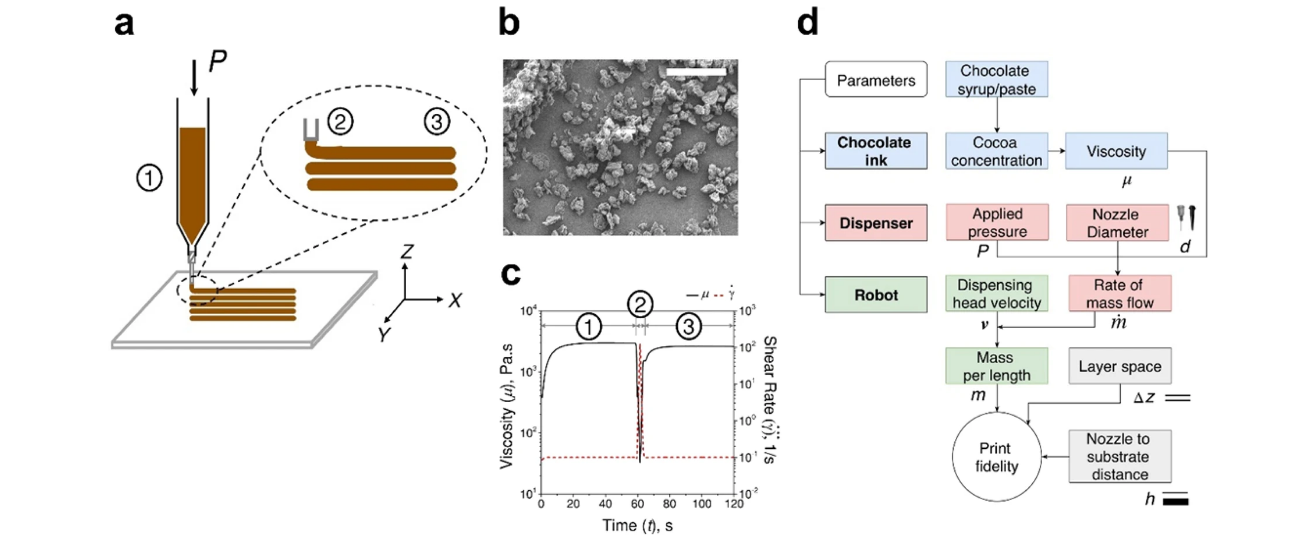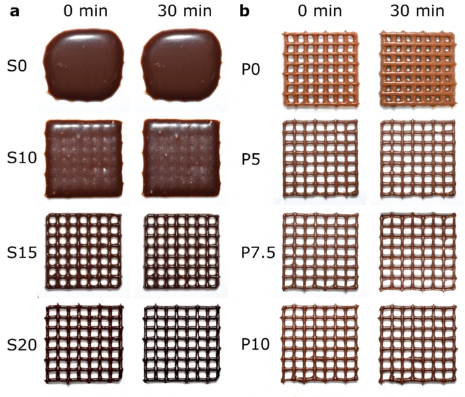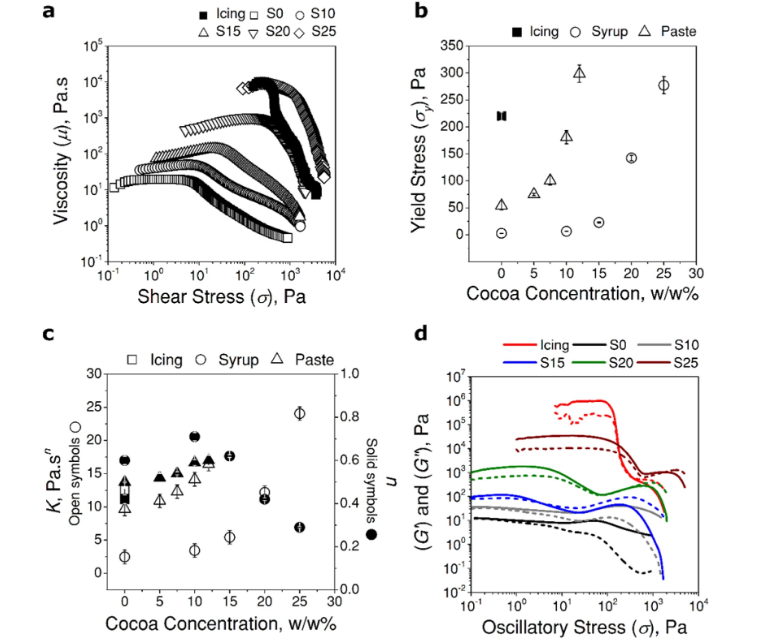In the recently published ‘Chocolate-based Ink Three-Dimensional Printing (Ci3DP),’ authors Rahul Karyappa and Michinao Hashimoto discuss the tasty merits of making desserts in 3D. Although printing in chocolate is not exactly a novelty anymore, there are still countless ways to serve it up, and here, the researchers from Singapore University of Technology and Design explore using chocolate-based inks in direct-ink writing (DIW)—while also coining a new abbreviation for chocolate-based ink 3D printing: Ci3DP.

Concepts of chocolate-based ink 3D printing (Ci3DP). (a) Schematic illustration of DIW of chocolate-based inks at room temperature. Shear-thinning flow of the ink facilitated easy extrusion through the syringe (Region 1) and the nozzle (Region 2). The ink exhibited fluid with yield stress behavior to form self-supporting layers after extrusion (Region 3). (b) SEM micrograph of cocoa powder used to prepare chocolate-based inks in Ci3DP. (c) Representative flow of chocolate-based ink during extrusion through syringe (Region 1), during extrusion through nozzle (Region 2), and after extrusion through nozzle (Region 3) by measuring μ with the change in γ˙ by rheometry. (d) Parameters in Ci3DP to be considered for printing. Scale bar = 50 μm.
They printed in both syrup and paste, using a variety of cocoa powder concentrations, without any temperature control. This is a ‘material’ used quite often these days for hot-melt extrusion, with chocolate becoming solid at room temperature.
“The rheological properties of the chocolate-based inks were studied to identify the properties suitable for DIW at the room temperature. To obtain good print fidelity, the effects of the three parameters of the printing—applied pressure (P), deposited mass of the ink per unit length (m) and the distance between two layers (Δz)—were studied,” stated the researchers.
The team endeavored to make both single and multiple chocolate-based inks, with the option for Ci3DP at room temperature. The printability of materials was based on both rheological properties of ink and DIW parameters, with commercial cake icing used as a reference point.
The researchers were looking for three features in their printing ink:
- Suitable rheological characteristics
- Proper dispensing of ink from the nozzle
- Good motion and control from the robot attached to syringe and nozzle
- Good shear thinning properties
The research team tested three different commercial products for printability, to include one icing, Hershey’s chocolate syrup, and Nutella, with formulated ink, stirred until ready and stored in a sealed bottle. The researchers then used a DIW 3D printer with a 3D printing robot and dispenser, employing a single syringe nozzle.

Effect of concentration of cocoa in the chocolate-based inks on the fidelity of printing, highlight the spreading of the inks. The 3D meshes (4 cm × 4 cm, 4 layers) consisting of chocolate-based materials were printed. 3D printed meshes of (a) syrup-based inks (S0 to S25), and (b) paste-based inks (P0 to P12) are shown at two timepoints: 0 min (immediately after printing) and 30 min after printing.
The inks for this project were both shear-thinning and able to solidify, forming layers during room temperature—allowing the team to eliminate hot-melt extrusion. Ci3DP also allowed the research team to create ink with liquid fillings employing multiple dispensers.
“Ci3DP is flexible and should be capable of fabricating customized food in a wide range of materials with tailored texture and nutritional content. The effect of addition of varying concentrations of cocoa powders in chocolate-based inks on the textural, nutritional and sensorial properties are to be studied,” concluded the researchers.
“This approach offers an alternative route of 3D modeling of food, especially when food ingredients or additives are sensitive to temperature. The use of multiple nozzles should offer interesting avenues to control distribution of the materials within the printed structure and shall find applications in the design of texture and controlled release of nutrients.”
3D printing offers so many valuable uses within industry and manufacturing; however, nothing gets us all more excited than the prospect of fabricating desserts! And especially chocolate, from creations inspired by nature to holiday themes, to specialty mashed potatoes.
What do you think of this news? Let us know your thoughts; join the discussion of this and other 3D printing topics at 3DPrintBoard.com.

Rheological characterization of syrup (S0), syrup with cocoa powder (S10 to S25), paste (P0), paste with cocoa powder (P5 to P12) and cake icing. (a) Viscosity (μ) as a function of applied shear stress (σ). (b) Yield stress (σy) measured from (a) as a function of concentration of cocoa in the inks. (c) Parameters of Herschel-Bulkley model (K – open symbols and n – solid symbols) as a function of concentration of cocoa in the inks. (d) Storage (G′, solid lines) and loss moduli (G′′, dashed lines) as a function of applied oscillatory shear stress (σ) for chocolate syrups (S0 to S25) and cake icing.
Subscribe to Our Email Newsletter
Stay up-to-date on all the latest news from the 3D printing industry and receive information and offers from third party vendors.
Print Services
Upload your 3D Models and get them printed quickly and efficiently.
You May Also Like
Heating Up: 3D Systems’ Scott Green Discusses 3D Printing’s Potential in the Data Center Industry
The relentless rise of NVIDIA, the steadily increasing pledges of major private and public investments in national infrastructure projects around the world, and the general cultural obsession with AI have...
Formlabs Teams Up with DMG MORI in Japan
In late June, Nick Graham, Chief Revenue Officer at Formlabs, announced on LinkedIn that the company had partnered with DMG MORI, one of the world’s leading machine tool companies, to...
EOS in India: AM’s Rising Star
EOS is doubling down on India. With a growing base of aerospace startups, new government policies, and a massive engineering workforce, India is quickly becoming one of the most important...
3D Printing News Briefs, June 25, 2025: R&D Materials, 3D Printed Veneers, & More
In today’s 3D Printing News Briefs, 3DXTECH has launched a program that gives customers early access to experimental materials, and the first Lithoz CeraFab Multi 2M30 in the Czech Republic...



































